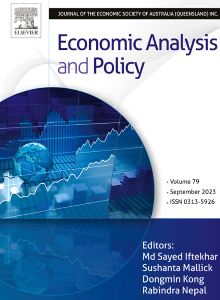官员地域轮换、知识溢出和区域创新协调发展
IF 8.7
2区 经济学
Q1 ECONOMICS
引用次数: 0
摘要
本文采用官员轮换作为准自然实验,整合企业对专利引文时空数据,对创新知识溢出进行测度。本文通过考虑地理距离、产业结构和文化差异等因素,考察了官员地域轮换对企业对创新知识跨区域溢出的影响。多期DID结果表明,市长或市委书记换届显著促进了上市公司创新知识的跨区域溢出。这一结果促进了各地区创新增长的更平衡,即使经过各种稳健性测试也保持一致。机制检验表明,官员轮换通过降低信息成本和打破市场分割促进创新知识溢出。渠道分析表明,官员的地域轮换通过其跨区域活动支持了企业间的知识溢出。此外,异质性检验表明,在沿海地区和中高技术产业的企业对中,官商联系越紧密,官员地域轮换的知识溢出效应越强。经济结果表明,官员轮换的知识溢出效应有助于缩小城市对创新差距,促进区域间创新能力的协调发展,并进一步推动欠发达地区创新绩效和质量的提升,且这种促进效应具有可持续性。本文丰富了创新知识溢出影响因素的研究内容。基于官员个体构建政府间关系网络的视角,为打破区域创新壁垒、促进区域创新协调发展提供了重要的文献支持。本文章由计算机程序翻译,如有差异,请以英文原文为准。
Officials geographical rotation, knowledge spillovers and coordinated development of regional innovation
This paper employs officials geographical rotation as a quasi-natural experiment and integrates the firm-pair patent citation spatiotemporal data to measure innovation knowledge spillovers. We examine how the official geographical rotation affects the firm-pair innovation knowledge cross-regional spillover by accounting for geographical distance, industrial structure, and cultural differences. Multi-period DID results indicate that rotating mayors or municipal party secretaries to new position significantly boosts the innovation knowledge cross-regional spillover from listed firms in their current position to those in their previous position. This result fosters more balanced innovation growth across regions and remains consistent even after various robustness tests. Mechanism test shows that officials geographical rotation promotes the innovation knowledge spillover by reducing information costs and breaking down market segmentation. Channel analysis reveals that officials geographical rotation supports interfirm knowledge spillovers through their cross-regional activities. Furthermore, heterogeneity test demonstrates that the firm pair in coastal regions and medium-to-high technology industries, with closer government-business connections, the stronger the knowledge spillover effect of officials geographical rotation. Economic consequence reveals that the knowledge spillover effect of officials geographical rotation helps narrow city-pair innovation gap, promotes interregional innovation capabilities coordinated development, and further drives the innovation performance and quality improvement in underdeveloped regions, with this facilitating effect being sustainable. Our paper enriches research on factors influencing innovation knowledge spillovers. Based on the perspective of intergovernmental relationship networks built by individual officials, it provides important literature support for breaking regional innovation barriers and promoting coordinated development of regional innovation.
求助全文
通过发布文献求助,成功后即可免费获取论文全文。
去求助
来源期刊

Economic Analysis and Policy
ECONOMICS-
CiteScore
9.80
自引率
9.20%
发文量
231
审稿时长
93 days
期刊介绍:
Economic Analysis and Policy (established 1970) publishes articles from all branches of economics with a particular focus on research, theoretical and applied, which has strong policy relevance. The journal also publishes survey articles and empirical replications on key policy issues. Authors are expected to highlight the main insights in a non-technical introduction and in the conclusion.
 求助内容:
求助内容: 应助结果提醒方式:
应助结果提醒方式:


